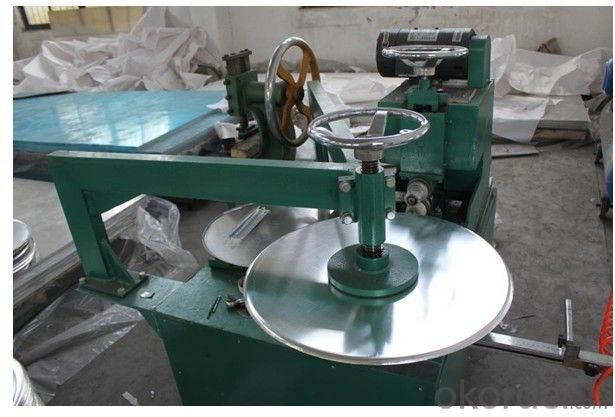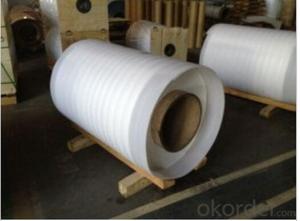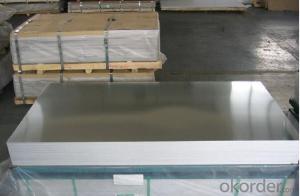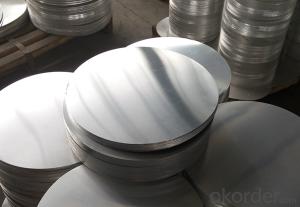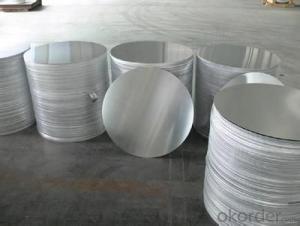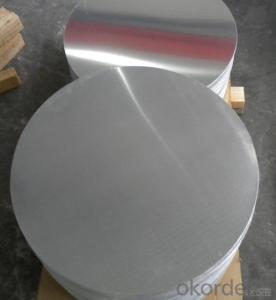Aluminum Sheets Mementos for Utensile Cookware
- Loading Port:
- Shanghai
- Payment Terms:
- TT OR LC
- Min Order Qty:
- 2 m.t.
- Supply Capability:
- 6000 m.t./month
OKorder Service Pledge
OKorder Financial Service
You Might Also Like
Specification
Aluminum Circle Plate for Utensile Cookware
Packaging & Delivery
| Packaging Details: | 25kg/carton-boxes(35*32*19CM) &Fumigation wooden-pallets (110*110*15cm) 20GP can loading 22 Ton,total 21 pallets,20 CBM. |
| Delivery Detail: | within 25 days |
Specifications
1).Excellent Surface Quality for lighting reflectors.
2).Excellent deep drawing and spinning quality.
3).Anodizing Quality
Aluminium circle/Aluminium discs/disks for cooking utensils Cookware
Aluminum disc Surface Finish: Bright & smooth surface, without flow lines, slightly oiled to avoid White rusting.Smooth,Brightly ,No Zone of Fracture ,No Scratched ,No oil Sludge
We enjoy a good reputation among our customers for our aluminum circle with high quality and competitive price, win high appreciation from our clients with the excellent workman-ship and professional ability. The quality matches with ISO 9001 quality management system.
It is equipped with 5 hot tandem rolling line, 4 cold mill production lines, 4 annealing surface machines and a complete finishing equipment.
Specification:
Alloy
Temper
Specification
Thickness
Diameter
1070,1050,3003,1100
O,H12,H14,H16
0.5-5.0mm
100-1200mm
Aluminum disc chemical Properties(WT.%)
Alloy
Si
Fe
Cu
Mn
Mg
Cr
Ni
Zn
Ca
V
Ti
Other
Min.A1
1050
0.25
0.4
0.05
0.05
0.05
-
-
0.05
-
0.05
0.03
0.03
99.5
1070
0.25
0.25
0.04
0.03
0.03
-
-
0.04
-
0.05
0.03
0.03
99.7
3003
0.6
0.7
0.05-0.2
1.0-1.5
-
-
-
0.1
-
-
-
0.15
96.95-96.75

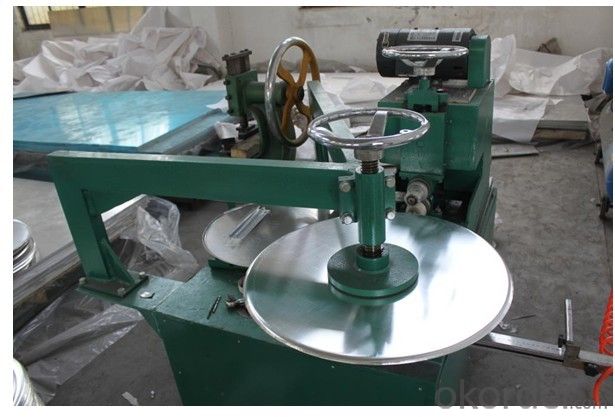
- Q: A dry aluminium foil paper can be bring out from oven with no burn on finger but if foil has some moisture it will result in burn why?
- It isn't the foil that is burning you--it's the water. Aluminum foil is a good heat conductor. This means that when you expose the foil to the air, it will cool off very rapidly (rapidly reaching room temperature). Water is NOT a good heat conductor, in fact, it likes to hold onto it's heat. So while the dry foil may come to room temperature (or just warm to the touch) in a few seconds, the water will stay hot for much longer (depending on how much water there is obviously). It's really the same as trying to grab a baked potato wrapped in foil off of the grill. If you grab the potato you will burn your hand (because the potato is holding A LOT of heat), but if you carefully peel away the foil, you can touch and take the foil off with your bare hand. I should say that the mass of the foil also plays a role here. The foil is not very massive and thus does not hold a lot of raw energy to begin with (also because it's a good heat conductor it dissipates quickly). Bu if you put an aluminum can (or a brick of aluminum) in the oven, I guarantee that it would stay hotter for much longer than just a piece of aluminum foil.
- Q: This question asks about the various types of aluminum sheets that are suitable for use in exterior applications, specifically those that can withstand outdoor conditions.
- <p>Aluminum sheets used for exterior applications come in various types, each with specific properties to withstand weather and environmental conditions. These include: 1. Mill Finish Aluminum Sheets: These have a natural aluminum finish and are used for applications requiring a raw, industrial look. 2. Anodized Aluminum Sheets: These are aluminum sheets that have been treated to increase their resistance to corrosion and wear. 3. Painted Aluminum Sheets: These are coated with a layer of paint for added protection and aesthetic appeal. 4. Embossed Aluminum Sheets: These have a textured surface and are used for decorative purposes or to provide a non-slip surface. 5. Perforated Aluminum Sheets: These are aluminum sheets with holes punched through them, used for ventilation or decorative purposes. Each type is chosen based on the specific requirements of the exterior application, such as durability, aesthetics, and environmental resistance.</p>
- Q: Can aluminum sheet be used for electrical connectors?
- Yes, aluminum sheet can be used for electrical connectors. Aluminum is a good conductor of electricity and is often used in electrical applications due to its high conductivity, lightweight nature, and cost-effectiveness. However, it is important to consider the specific requirements and conditions of the electrical system to determine if aluminum sheet is suitable for a particular connector application.
- Q: This question asks for the various types of surface treatments or coatings that can be applied to aluminum profiles to enhance their properties or appearance.
- <p>Aluminum profiles can be coated with several types of finishes to improve their aesthetic appeal, durability, and corrosion resistance. The common types include: 1) Anodizing, which creates a protective oxide layer on the aluminum surface; 2) Powder coating, where a dry powder is electrostatically applied and then cured under heat; 3) Electrophoretic coating, a method where charged particles adhere to the aluminum and then harden; 4) PVDF (Polyvinylidene Fluoride) coating, known for its excellent weather resistance and durability; 5) Thermal spraying, where a coating material is melted and sprayed onto the aluminum surface; and 6) Painting, which can be done through various methods such as airless spray or dip coating. Each type of coating serves different purposes and has its own set of advantages and applications.</p>
- Q: What are the different methods of joining aluminum sheet?
- Some of the different methods of joining aluminum sheet include welding, adhesive bonding, riveting, clinching, and mechanical fastening.
- Q: i m not sure if aluminum hydroxide is a acid or base. if somebody could help me, i will really appreciate.If u can could you also tell me if im wrong or right about the following substances:- pepsi cola is acid- vinegar is a base- ammonia is a base- aluminum hydroxyde is ?thank u for your help.
- anything hydroxide is basic (it refers to the OH-) pepsi has citric acid in it, therefore it is an acid vinegar is acetic acid, and is therefore acidic ammonia is certainly a base and aluminum hydroxide is basic (see above)
- Q: What is the difference between aluminum plate AL1050 and AL1060?
- 1050 and 1060 belong to an aluminum plate, that is, pure aluminum plate, the difference is that the content of aluminum is different. 1050 aluminum content 99.95%, 1060 Aluminum Content 99.60%, material is very close, often can replace the use, the current use is more than 1060 Aluminum plate.Is the aluminum plate with a thickness of more than 0.2mm to 500mm, 200mm width, length less than 16m aluminum material called aluminum plate or aluminum sheet, aluminum is below 0.2mm, 200mm within the width of the row material or bar (of course, with the progress of the large equipment, the width can be 600mm row material also more). Aluminum sheet refers to the rectangular plate made of aluminium ingot rolled and divided into pure aluminum plate, alloy aluminum plate, thin aluminum plate, middle thick aluminum plate and pattern aluminum plate.
- Q: What are the common aluminum sheets and the best ones?
- That depends on what you are doing, and commonly used on 3003 and 5052, the performance is better to use 6061
- Q: Can aluminum sheets be laminated with other materials?
- Yes, aluminum sheets can be laminated with other materials. Lamination involves bonding different layers together to create a composite material with enhanced properties and functionality. Aluminum sheets can be laminated with various materials such as polymers, fabrics, or other metals to improve their strength, durability, insulation, or aesthetic appearance. This process allows for the customization and optimization of aluminum sheets for specific applications.
- Q: Can aluminum sheets be used for insulation purposes?
- Aluminum sheets are capable of being used for insulation purposes. Due to its high thermal conductivity, aluminum serves as an efficient heat conductor. Nevertheless, in order to enhance insulation efficacy, aluminum sheets are typically combined with other substances. One common example is aluminum foil insulation, which involves combining aluminum foil with materials like foam or fiberglass to establish a heat transfer barrier. The reflective nature of aluminum further aids in deflecting radiant heat, thereby amplifying its insulation capabilities. In summary, although aluminum sheets alone may not offer ample insulation, they can be effectively utilized in conjunction with other materials to construct insulation systems suitable for diverse applications.
Send your message to us
Aluminum Sheets Mementos for Utensile Cookware
- Loading Port:
- Shanghai
- Payment Terms:
- TT OR LC
- Min Order Qty:
- 2 m.t.
- Supply Capability:
- 6000 m.t./month
OKorder Service Pledge
OKorder Financial Service
Similar products
Hot products
Hot Searches
Related keywords


